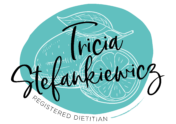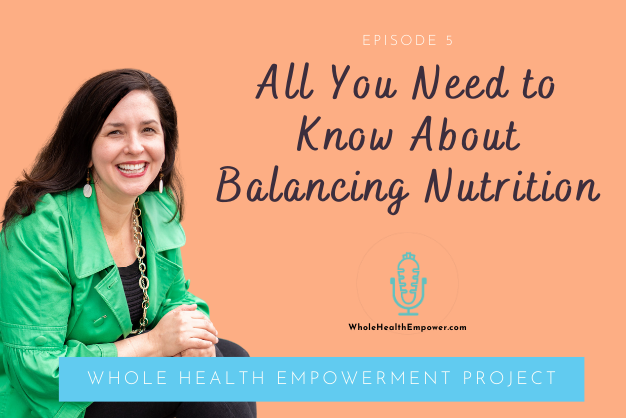Today’s episode will explore the topic of balanced nutrition, what it is, why it’s important, and tips to get you started.
Episode Resources:
On Episode 3 we talked about the healthy mom/women trifecta of self- care, nutrition, and movement. Last week, we talked to Dr. Nancy Maguire about self-care so today we will explore the topic of balanced nutrition, what it is, why it’s important, and tips to get you started.
My family history probably looks something like yours: filled with diabetes, heart disease, high blood pressure, high cholesterol, and weight abnormalities. Studying nutrition was a way for me to figure how to change that family history with the foods that I ate. It was a way for me to exert some form of control over my own health which is much easier to do when life is controlled. When my son was a newborn, I went through this 2-week phase of eating only peanut butter M&M’s. I could barely walk but somehow was so motivated to get those damn M&M’s that I would walk my butt down three flights of stairs from my apartment to the local pharmacy to get them. During this period, I was trying to survive the 3-4-hour feedings per day, pack for an upcoming move, and deal with pain from a c-section and hip fracture. Those M&M’s offered the perfect snack of being quick, easy, calorie dense, and emotionally satisfying. Did I know that I could be eating something better that would provide nourishment for me and the baby? Yes obviously. But those M&M’s were all I could physically and emotionally muster at that point in my life. Making and preparing food was low on my priority list and I was fighting to get through each day in one piece.
I know that I am not the only one who has gone through a season like this. I’m pretty sure all of us have had experiences and periods in our lives, when we are on full survival mode and focusing on nutrition just isn’t a priority. But why does it have to be like that? That M&M period of my life was about avoiding and surviving. I don’t know if I could have done it better and it doesn’t really matter. What does matter is that I now recognize the behavior I used to survive. I can choose to continue with that behavior or do something different. I am making a conscious mindset shift from: Eating to avoid emotions TO eating to help me feel strong, empowered, and in control.
You can choose how you want to get through your next hardship too if eating is how you deal with it. You can do what you always do, or you can choose something different. Implementing one strategy at a time starting now, every day, over time help you create a strong nutritional foundation of health. Providing some nutrition knowledge may be a way for you to create this groundwork.
What nutrition is and why is it important?
Nutrition is getting the nutrients we need to nourish our body by the foods we eat every day. Each of these foods provide a different function and go into the cells that need them to help the body run efficiently. The goal is to have a balance of these nutrients as each food plays a different role in helping the body function properly. When there is an imbalance of nutrients, there is an increased risk for developing health conditions related to the imbalance.
Nutrition is important as it helps nourish and feed our bodies and helps maintain overall health of our body. Balanced nutrition helps prevent or reduce risk of diseases, including obesity, high blood pressure, diabetes, heart disease, some forms of cancer, cholesterol, and stroke. Balanced nutrition helps our bodies heal and grow, fight illness, recover from illness or injury, increase energy levels, acts as fuel for the body during exercise, and maintain a healthy weight.
Having an imbalance of nutrition for a few weeks is very different than having that imbalance over many years. Typically having this imbalance over a longer period will ultimately lead to complications. The goal is to focus on strategies that over time will create more of a balance in the foods we eat and avoid the complications mentioned
To figure out where best to start on making changes in what we eat, we can look at the 2015-2020 Dietary Guidelines for Americans for recommendations.
This guideline shows eating patterns among the US population and gives us an idea of what as a population we can improve on. As I go through the brief descriptions, you will be able to identify any changes that you could make, that over time, would lead you to greater nutritional balance. Some quick finding includes:
- US population has eating pattern:
- Low: vegetables, fruit, whole grain, dairy, seafoods, oil
- 75% of US population has an eating pattern that eats less than the recommended intake for veggies, fruits, dairy, and oils
- High: refined grains, high in meats, poultry
Continuing to follow this US pattern of eating could lead to an imbalance of nutrition, over time, as it is low in the very things that help provide vitamins, minerals, fiber, calcium and vitamin D to our cells that require them. We will talk about the different food groups and how to balance your nutritional profile. However, I do want to note that there will be disease states that will hinder the amount of some of these food groups that I will review. For instance, for someone with irritable bowel may not be able to eat whole grains when in a flare.
Also, to remember, if you are someone who already has a chronic condition, you too can find benefit in making small changes in the way you eat such as less medication or improvement in symptoms.
Veggies
- Include: Fresh, frozen, low sodium canned, low sodium vegetable juices
- Most eaten vegetables: Potatoes, tomato – for most of us this is a category that we can improve on.
- Provide: multitude of vitamins, minerals, fiber
Fruit
- Includes: fresh, frozen, canned, dried (higher in calories) 100% fruit juice (lower in fiber than whole fruit)
- Provides fiber, vitamins
Grains
- As a group include: Breads, pasta, cereal, oatmeal, rice
- Broken down further into refined grains and whole grains
- Refined grains: white bread, rolls, bagels, crackers, pasta, white rice, cakes, cookies, pastries
- More processed, less fiber, vitamins, minerals, iron than whole grain
- Whole grains: oatmeal, brown rice, whole wheat pasta, quinoa
- Whole grain: fiber, vitamins, minerals, iron
- Refined grains: white bread, rolls, bagels, crackers, pasta, white rice, cakes, cookies, pastries
Dairy
- low fat or fat free, milk, yogurt, cheese, soymilk
- Other milks made from plants include almond, rice, coconut, hemp – have calcium but don’t have the same nutritional content as milk and soymilk as they have less calories and typically less protein. Cow and soymilk have 8 g protein vs. 1 g protein in plant milk
- Vitamins, minerals including Calcium and vitamin D
Proteins
- lean meats, turkey, chicken, pork, fish, eggs
- vegetarian options including beans, nuts, seeds, soy
- Function: for building blocks for our bones, muscles, and skin; build and repair our tissues.
Oils
- Canola, corn, olive, peanut, safflower, soybean and sunflower oils (also part of olives, avocados)
- Help transport fat soluble vitamins in A, D E and K into cells, also contain essential fatty acids.
The amount to eat of each of these categories of food varies on how many calories you require each day which varies according to gender, height, weight, age, and movement level. For instance, someone following a 1400 calorie diet needs less of the food groups than someone who is following a 2000 calorie diet.
How to get started:
Let’s talk about some practical ways to get you started in creating a more balanced nutritional approach in your own life. My best piece of advice is start where you’re at. Figure out where you could make some changes.
If goal is to increase veggie/fruit intake
- Add extra veggie/fruit to a smoothie
- Plant a garden with veggies/fruit and add to meals
- Try a different fruit or veggie each week, variety of veggies with difference colors to increase nutrition
- Cut up veggies/fruit to have on hand ahead of time
- Have an extra veggie or fruit with each meal
- Fill up 50% meal plate with v/f, 25% starch, 25% protein
If the goal is to increase whole grains/decrease refined grains:
- look for 100% whole grain foods, whole grain first few ingredients, look at fiber content
- Decrease the number of cookies, cakes, snacks consumed
Other tips:
- limit processed meats like hot dogs, sausages, lunch meat
- Limit: coconut, palm, butter, shortening
- Add variety of foods within all food groups
Start where you’re at.
Start by implementing small changes into how you eat, seeing what works, make changes, and then continue to build and create a foundation that works for you. There is no “right or wrong” way to do this. It’s more of what is right for you and what you can maintain your health for the long term. It’s a way that you can create your own meal plan and become more confident that what you are doing is right for you.
I have a free meal planning guide on my website that you can download for more ideas.
This journey will take time and effort and may even require you to step outside of your comfort zone. It won’t be perfect. Done is better than perfect. Whole Health is not an impossibility – but only you can make it happen. I don’t have it figured out, but I know I can do a better job than I am doing now. You may feel that way too. Remember to start where you’re at. It’s not about being perfect, it’s about being 1% better each day.
Be kind to yourself friends.

